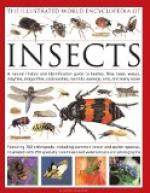When examined by a microscope, the flea is a pleasant object. The body is curiously adorned with a suit of polished armour, neatly jointed, and beset with a great number of sharp pins almost like the quills of a porcupine: it has a small head, large eyes, two horns, or feelers, which proceed from the head, and four long legs from the breast; they are very hairy and long, and have several joints, which fold as it were one within another.
LOUSE.
[Illustration]
These loathsome animals, however unwelcome, attend in troops, and add to the afflictions of the unfortunate and lazy; but they are routed by the hand of industry and cleanliness.
In examining the louse with a microscope, its external deformity strikes us with disgust. It has six feet, two eyes, and a sort of sting, proboscis, or sucker, with which it pierces the skin, and sucks the blood. The skin of the louse is hard and transparent, with here and there several bristly hairs: at the end of each leg are two claws, by which it is enabled to lay hold of the hairs, on which it climbs. There is scarcely any animal known to multiply so fast as this unwelcome intruder: from an experiment of Lieuenhoek, a louse in eight weeks, may see five thousand of its descendants.
Among the ancients, what is called the lousy disease was not uncommon: Antiochus, Herod, and others are said to have died of this disorder.
ITCH ... MITE.
[Illustration]
Chego ... Deathwatch.
There are many species of mites, beside the itch animal and mite above: to the naked eye, they appear like moving particles of dust: but the microscope discovers them to be perfect animals, having as regular a figure, and performing all the functions of life as perfectly as creatures that exceed them many times in bulk: their eggs are so small that a regular computation shews that 90 millions of them are not so large as a common Pigeon’s egg.
The Chego is a very small animal, about one fourth the size of a common flea: it is very troublesome, in warm climates, to the poor blacks, such as go barefoot, and the slovenly: it penetrates the skin, under which it lays a bunch of eggs, which swell to the bigness of a small pea.
The Deathwatch, of which there are two kinds, is an insect famous for a ticking noise, like a watch, which superstitious people take for a presage of death, in the family where it is heard.
SCORPION.
[Illustration]
This is one of the largest of the insect tribe. It is met with in different countries, and of various sizes, from two or three inches to nearly a foot in length: it somewhat resembles a lobster, and casts its skin, as the lobster does its shell.




